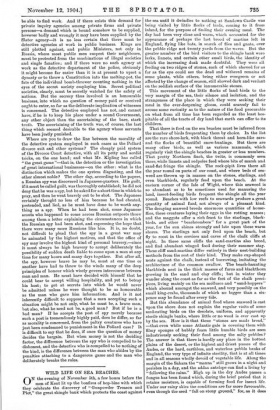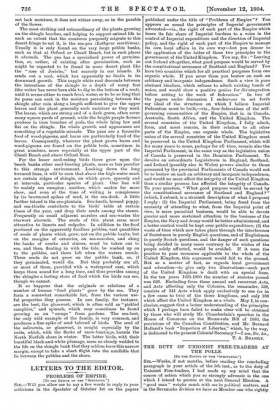the sea until ib dwindles to nothing at Sandown Castle
wks being visited by little flocks of birds, coming to it from inland, for the purpose of finding their evening meal. The day had been very close and warm, which accounted for the appearance of perhaps the last brood of martins left in England, flying like bats, in search of flies and gnats, over the pebble ridge not twenty yards from the waves. But the greater number of the bird visitors to the shingle bank wore larks, linnets, and certain other small birds, the identity of which the increasing dusk made doubtful. They were all feeding on two ridges of stones, each of which showed for as far as the eye could see the dead and withered remains of some plants, while others, being either evergreen or not affected by the change of season, still showed dark and verdant on the reddish surface of the innumerable stones.
This movement of the little flocks of land birds to the very margin of the sea, their silence and isolation, and the strangeness of the place in which they were seeking their meal in the ever-deepening gloom, could scarcely fail to arouse some curiosity as to the nature of the food procurable on what from all time has been regarded as the least hos- pitable of all the tracts of dry land that earth can offer to its children.
That there is food on the sea beaches must be inferred from the number of birds frequenting them by choice. In the list are the rare shore-lark, with black throat and horn-like ears, and the flocks of beautiful snow-buntings. But there are many other birds, as well as various mammals, which regularly visit the shingle beaches in greater or less numbers. That pretty Northern finch, the twite, is commonly seen there, while linnets and redpoles feed where bits of marsh and sand-flat fringe the shingle. The rock-pipit lives there all the year round on parts of our coast, and where beds of sea- weed are thrown up in masses on the stones, starlings, and even blackbirds, regularly feed upon the beach. At the eastern corner of the Isle of Wight, where this seaweed is so abundant as to be sometimes used for manuring the land, insect-feeding birds frequent the shingle all the year round. Beaches with low reefs to seawards produce a great quantity of animal food, not always of a pleasant kind. The decaying seaweed breeds enormous quantities of house- flies, these creatures laying their eggs in the rotting masses ; and the maggots offer a rich feast to the starlings, black- birds. and other " beachcombers" for a great part of the year, for the sun shines strongly and late upon these warm shores. The starlings not only feed upon the beach, but fly to roost in the crevices and caves of the chalk cliffs at night. In these same cliffs the sand-martins also breed, and find abundant winged food during their summer stay. These cliff sand-martins differ entirely in their nest-building methods from the rest of their kind. They make cup-shaped nests against the chalk, instead of burrowing, imitating the architecture of the common swallow. The beach-haunting blackbirds nest in the thick masses of furze and blackthorn growing in the sand and clay cliffs ; but in winter they wander along the coast as far as the feet of the chalk preci- pices, living mainly on the sea molluscs and " sand-hoppers " which abound amongst the seaweed, and very possibly on the small king-crabs, thousands of which no bigger than a six- pence may be found after every tide.
But this abundance of animal food where seaweed is cast upon the shore does not explain the regular visits of some seed-eating birds on the desolate, uniform, and apparently sterile shingle banks, where little or no weed is ever cast up by the sea. How is it that these " stones are made bread," —that even while some Atlantic gale is covering them with filmy sponges of bubbly foam little humble birds are seen industriously seeking their food among the salty pebbles ? The answer is that there is hardly any place in the hottest plains of the desert, or the highest and driest passes of the Andes, or the hard, earthless, and waterless pebble banks of England, the very type of infinite sterility, that is at all times and in all seasons wholly devoid of vegetable life. Along the margin of the Sahara the " manna " still grows in a night and perishes in a day, and the addax antelope can find a living by "following the rains." High up in the dry Andes passes a fungus has been found which, during the brief period that it retains moisture, is capable of forming food for insect life. Under our rainy skies the conditions are far more favourable, even though the seed "fall on stony ground," for, as it does
The most striking and extraordinary of the plants growing on the shingle beaches, and helping to support animal life to such an extent that the creatures purposely migrate to this desert fringe to eat it, is the sea-pea (Lathyrus maritimus). Usually it is only found on the very large pebble banks, such as that at Orford or Chesil Beach, but in such places it abounds. The pea has a specialised power of germina- tion, or, rather, of existing after germination, such as might be expected to be found in some desert plant like the " rose of Jericho," but scarcely in our islands. It sends out a root, which has apparently no limits in its downward growth. This supple white root descends between the interstices of the shingle to a depth of many feet (the writer has never been able to dig to the bottom of a root), until it seems either to reach fresh water, or to be so long that its pores can sack in the moisture percolating between the shingle after rain along a length sufficient to give the upper leaves and the plant generally such moisture as they need.
The leaves, which are strong and of a dark green, often cover many square yards of ground, while the bright purple flowers produce in turn bunches of pods, the whole lying low and flat on the shingle. Its whole growth and appearance are something of a vegetable miracle. The peas are a favourite food of wood-pigeons, and hares are particularly fond of the leaves. Consequently, wherever the plant •grows hares and wood-pigeons are found on the pebble beds, sometimes in great numbers, more especially at the upper part of the Chesil Beach and above Orford Ness.
For the lesser seed-eating birds there grow upon the beach banks other seed-bearing plants, more or less peculiar to this strange environment. Looking down the long terraced lines, it will be seen that above the high-water mark are certain ridges of shingle, on which grow, sparsely and at intervals, particular species of plant. One line will be mainly sea tampion; another, which makes far more show, and even at the time of writing is conspicuous by its brown-red spikes of seed, is the sea-dock. A little further inland is the sea-plantain. Sea-heath, horned poppy, and sea-thistle contribute to the birds table at certain times of the year, and drop their seeds among the stones.
Frequently on small adjacent marshes and sea-wastes the starwort abounds. The seeds of this plant seem most attractive to linnets and redpoles. In addition to the food produced on the apparently foodless pebbles, vast quantities of seeds of plants which grow, not on the pebble banks, but on the margins of estuaries, on sea-marshes, and along the banks of creeks and sluices, must be taken out to sea, and then, floating in with the tide, be washed up on to the pebbles, and there left when the waters recede.
These seeds do not grow on the pebble bank, or, if they germinated, would die. But they probably are all, or most of them, provided with a waterproof case, which keeps them sound for a long time, and thus provides among the shingles a lasting store of food which the birds can see, though we cannot.
It so happens that the originals or relations of a number of human "food plants" grow by the sea. They form a somewhat remarkable list, from the various use- ful properties they possess. In one family, for instance, are the beet, the glasswork which is often sold as "pickled samphire," and spinach, which may sometimes be found growing as an " escape " from gardens. The sea-beet, the only wild example of the family, is very common, and produces a fine spike of seed beloved of birds. The seed of the salicornia, or glasswork is sought especially by the twite, which, with the flocks of snow-buntings, haunts the North Norfolk shore in winter. The latter birds, with their beautiful black-and-white plumage, seem so closely wedded to the life on the shingle bank that they seldom leave this narrow margin, except to take a short flight into the sandhills that lie between the pebbles and the shore.
LETTERS TO THE .EDITOR.











































 Previous page
Previous page